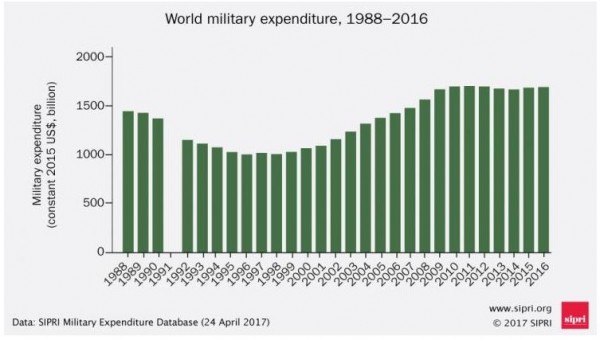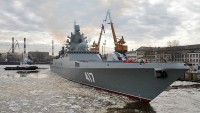Threats posed by Russia, China, Islamic Terrorism Fuel Boost in World Military Spending in 2016
| Arthur Dominic Villasanta | | Apr 24, 2017 07:23 AM EDT |
(Photo : SIPRI) World military expenditures, 1988-2016.
Islamic terrorism, Chinese imperialism and Russian neo-imperialism were the main factors driving the world's staggering appetite for weapons, which reached $1.69 trillion in 2016, the second highest spending on record.
This staggering amount was equivalent to 2.2 per cent of global GDP, said the Stockholm International Peace Research Institute (SIPRI), which monitors developments in military expenditure worldwide. SIPRI maintains the most comprehensive, consistent and extensive data source available on military expenditure.
Like Us on Facebook
In its latest report on the state of the world's military spending, SIPRI said the rise in overall defense spending in 2016 was the first consecutive annual increase since 2011 when spending reached its peak of $1.7 trillion.
The United States, China and Russia were the world top three military spenders in 2016.
The United States was again the country with the highest annual military expenditure in the world. U.S. military spending grew by 1.7 percent between 2015 and 2016 to $611 billion.
Military expenditures by China, which was the second largest spender in 2016, jumped by 5.4 percent to $215 billion, a much lower rate of growth than in previous years.
Russia increased its spending by 5.9 percent in 2016 to $69.2 billion, making it the third largest spender.
Saudi Arabia was the third largest spender in 2015 but dropped to fourth in 2016. Spending by Saudi Arabia fell by 30 percent in 2016 to $63.7 billion, despite its continued involvement in regional wars.
India's military expenditure grew by 8.5 percent in 2016 to $55.9 billion, making it the fifth largest spender.
SIPRI said the growth in U.S. military expenditure in 2016 may signal the end of a trend of decreases in spending, which resulted from the economic crisis and the withdrawal of US troops from Afghanistan and Iraq.
U.S. spending in 2016, however, was 20 percent lower than its peak in 2010.
"Despite continuing legal restraints on the overall U.S. budget, increases in military spending were agreed upon by Congress," said Dr. Aude Fleurant, Director of the SIPRI Arms and Military Expenditure (AMEX) program.
"Future spending patterns remain uncertain due to the changing political situation in the USA."
Military expenditure in Western Europe rose for the second consecutive year and was up by 2.6 percent in 2016. There were spending increases in all but three countries in Western Europe. Italy recorded the most notable increase, with spending rising by 11 percent between 2015 and 2016.
The countries with the largest relative increases in military spending between 2015 and 2016 are in Central Europe, which is facing a threat of a military invasion by Russia. Overall spending in Central Europe grew by 2.4 percent in 2016.
"The growth in spending by many countries in Central Europe can be partly attributed to the perception of Russia posing a greater threat," said Siemon Wezeman, Senior Researcher with the SIPRI AMEX programme.
"This is despite the fact that Russia's spending in 2016 was only 27 percent of the combined total of European NATO members."
Large falls in military expenditure in many oil-exporting countries, especially those in the Middle East
"Falling oil revenue and associated economic problems attached to the oil-price shock has forced many oil-exporting countries to reduce military spending," said Dr. Nan Tian, Researcher with the SIPRI AMEX programme.
"For example, between 2015 and 2016 Saudi Arabia had the biggest absolute decrease in spending of $25.8 billion."
The largest cuts in military expenditure in 2016 related to falling national oil revenues were in Venezuela (-56 per cent); South Sudan (-54 per cent); Azerbaijan (-36 per cent); Iraq (-36 per cent) and Saudi Arabia (-30 per cent).
TagsStockholm International Peace Research Institute, sipri, world military spending, United States, china, Russia
©2015 Chinatopix All rights reserved. Do not reproduce without permission
EDITOR'S PICKS
-

Did the Trump administration just announce plans for a trade war with ‘hostile’ China and Russia?
-

US Senate passes Taiwan travel bill slammed by China
-

As Yan Sihong’s family grieves, here are other Chinese students who went missing abroad. Some have never been found
-

Beijing blasts Western critics who ‘smear China’ with the term sharp power
-

China Envoy Seeks to Defuse Tensions With U.S. as a Trade War Brews
-

Singapore's Deputy PM Provides Bitcoin Vote of Confidence Amid China's Blanket Bans
-

China warns investors over risks in overseas virtual currency trading
-

Chinese government most trustworthy: survey
-

Kashima Antlers On Course For Back-To-Back Titles
MOST POPULAR
LATEST NEWS
Zhou Yongkang: China's Former Security Chief Sentenced to Life in Prison

China's former Chief of the Ministry of Public Security, Zhou Yongkang, has been given a life sentence after he was found guilty of abusing his office, bribery and deliberately ... Full Article
TRENDING STORY

China Pork Prices Expected to Stabilize As The Supplies Recover

Elephone P9000 Smartphone is now on Sale on Amazon India

There's a Big Chance Cliffhangers Won't Still Be Resolved When Grey's Anatomy Season 13 Returns

Supreme Court Ruled on Samsung vs Apple Dispute for Patent Infringement

Microsoft Surface Pro 5 Rumors and Release Date: What is the Latest?













